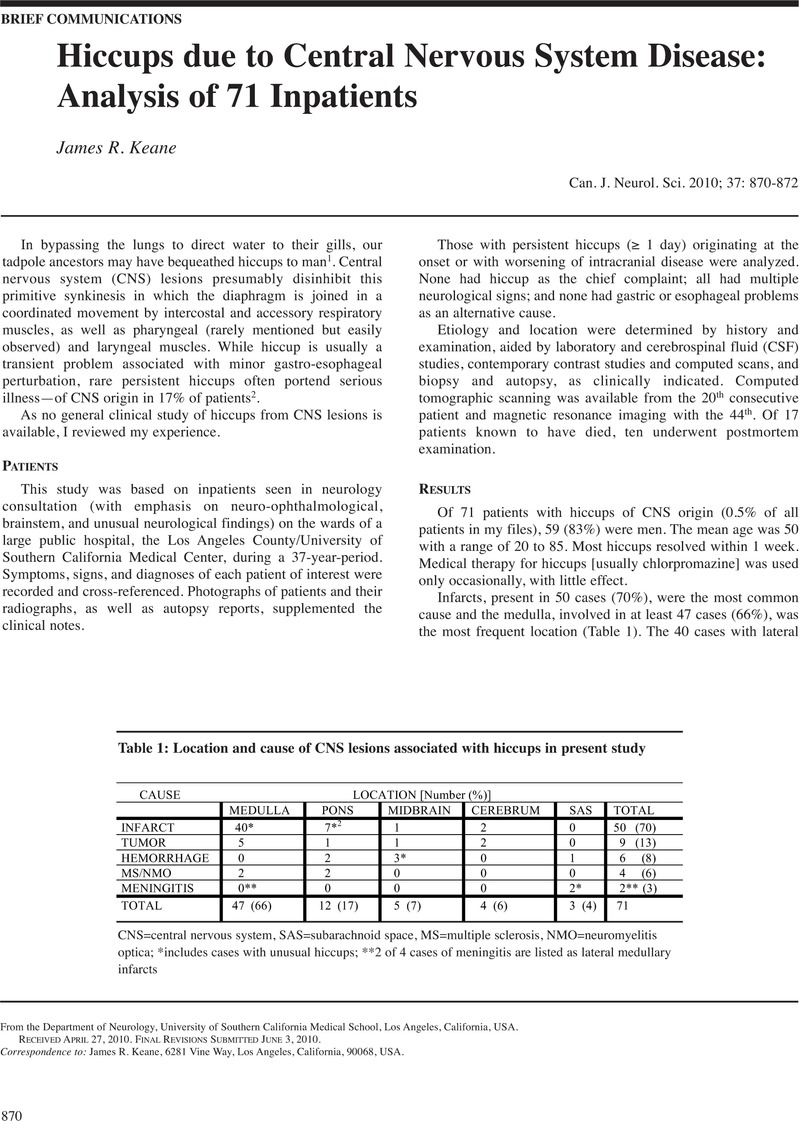Crossref Citations
This article has been cited by the following publications. This list is generated based on data provided by Crossref.
John, Seby
Parambil, Joseph
Culver, Daniel
and
Tavee, Jinny
2012.
Medullary neurosarcoidosis presenting with intractable hiccoughs.
Journal of Clinical Neuroscience,
Vol. 19,
Issue. 8,
p.
1193.
Thaci, Bart
Burns, Joseph D.
Delalle, Ivana
Vu, Thai
and
Davies, Keith G.
2013.
Intractable hiccups resolved after resection of a cavernous malformation of the medulla oblongata.
Clinical Neurology and Neurosurgery,
Vol. 115,
Issue. 10,
p.
2247.
Shastin, Dmitri
Nidamanuri, Priya
and
Nannapaneni, Ravindra
2018.
Recurrent hiccups may signal brainstem pathology and should be investigated.
BMJ Case Reports,
p.
bcr-2017-222926.
Son, Hee-won
Cho, Young Woo
Kim, Young-ung
and
Shin, Yong-joon
2018.
Stellate ganglion block for the treatment of intractable hiccups - A case report -.
Anesthesia and Pain Medicine,
Vol. 13,
Issue. 2,
p.
192.
Chon, Jinmann
Yoo, Seung Don
and
Lee, Seung Ah
2020.
Hiccups triggered by bladder filling after bilateral pontine hemorrhage.
Medicine,
Vol. 99,
Issue. 14,
p.
e19338.
Niedermeyer, Sebastian
Greve, Tobias
Lamm, Ludwig-Maximilian
Thorsteinsdottir, Jun
Schichor, Christian
Tonn, Joerg-Christian
and
Szelényi, Andrea
2022.
Acute Hiccups Detected by Electromyographic Recordings During Resection of a Vestibular Schwannoma.
Operative Neurosurgery,
Vol. 23,
Issue. 4,
p.
e298.
Shankar, Takshak
Pillai, Aadya
Kaeley, Nidhi
and
Vempalli, Nagasubramanyam
2022.
Intractable hiccups as the harbinger of a diffuse pontine glioma.
BMJ Case Reports,
Vol. 15,
Issue. 3,
p.
e247830.
He, Jiahui
Guan, Ao
Yang, Tingting
Fu, Lijuan
Wang, Yourui
Wang, Shaoshuang
Ren, Haomin
Chen, Ling
Zhu, Yaomin
and
Deng, Bin
2025.
Pathogenesis and treatment of perioperative hiccups: a narrative review.
Annals of Medicine,
Vol. 57,
Issue. 1,



